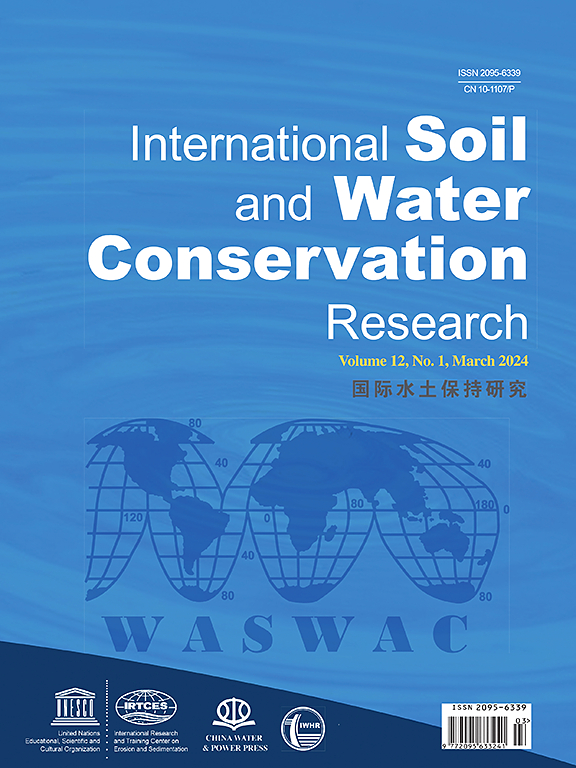Impact of soil compaction on the rill erosion of Mollisol by waterflow: A comparative analysis before and after the seasonal freezing and thawing
IF 7.3
1区 农林科学
Q1 ENVIRONMENTAL SCIENCES
International Soil and Water Conservation Research
Pub Date : 2025-05-21
DOI:10.1016/j.iswcr.2025.05.006
引用次数: 0
Abstract
Soil erosion resulting from soil compaction and freeze-thaw action is a major global environmental issue in intensively mechanized agricultural and cold regions. Existing studies predominantly focus on the direct effects of freeze-thaw cycles on soil erosion, yet overlook the legacy effects of pre-freeze-thaw soil compaction. This study aimed to reveal the cross-temporal impact mechanisms of pre-freeze-thaw soil compaction on post-freeze-thaw soil erosion and how soil properties drive these effects. A comparative study was conducted in the Mollisol region of Northeast China by utilizing in situ field erosion experiments and soil property measurements under various compaction levels before and after the freeze-thaw period. Results showed that before the freeze-thaw period, compaction significantly increased total runoff and sediment mass (p < 0.05). After the freeze-thaw period, the sediment mass of compacted soil decreased by 1.84 %–57.73 % compared to before the freeze-thaw period, but still increased by 28.59 %–148.22 % compared to uncompacted soil. The structural equation model revealed that before the freeze-thaw period, the influence of soil properties on runoff was greater than their direct effect on sediment mass, and the sediment mass variation was mainly driven by runoff scouring due to soil compaction. After the freeze-thaw period, the decreased soil erosion resistance (aggregate stability and soil strength) and the increased runoff caused by the legacy effects of compaction were the primary reasons for higher sediment mass in compacted soil compared to uncompacted soil. This study highlights the crucial role of human activities before the freeze-thaw period in influencing subsequent erosion dynamics, providing essential insights for erosion control and soil restoration in vulnerable farmlands.
土壤压实对水流对Mollisol细沟侵蚀的影响:季节冻融前后的对比分析
土壤压实和冻融作用导致的土壤侵蚀是农业集约化和寒冷地区的主要全球性环境问题。现有研究主要关注冻融循环对土壤侵蚀的直接影响,而忽视了冻融前土壤压实的遗留效应。本研究旨在揭示冻融前土壤压实对冻融后土壤侵蚀的跨时间影响机制,以及土壤性质如何驱动这些影响。采用冻融前后不同压实程度下的土壤侵蚀试验和土壤性质测量,对东北Mollisol地区进行了对比研究。结果表明,冻融期前,压实作用显著增加了总径流量和泥沙量(p < 0.05)。冻融期结束后,压实土的沉积物质量比冻融前减少了1.84% ~ 57.73%,但仍比未压实土增加了28.59% ~ 148.22%。结构方程模型表明,在冻融期之前,土壤性质对径流的影响大于其对沙质的直接影响,沙质变化主要由土壤压实引起的径流冲刷驱动。冻融期后,压实遗留效应导致的土壤抗侵蚀能力(团聚体稳定性和土壤强度)下降和径流量增加是压实土比未压实土含沙量大的主要原因。该研究强调了冻融期前人类活动对随后侵蚀动态的重要影响,为脆弱农田的侵蚀控制和土壤修复提供了重要的见解。
本文章由计算机程序翻译,如有差异,请以英文原文为准。
求助全文
约1分钟内获得全文
求助全文
来源期刊

International Soil and Water Conservation Research
Agricultural and Biological Sciences-Agronomy and Crop Science
CiteScore
12.00
自引率
3.10%
发文量
171
审稿时长
49 days
期刊介绍:
The International Soil and Water Conservation Research (ISWCR), the official journal of World Association of Soil and Water Conservation (WASWAC) http://www.waswac.org, is a multidisciplinary journal of soil and water conservation research, practice, policy, and perspectives. It aims to disseminate new knowledge and promote the practice of soil and water conservation.
The scope of International Soil and Water Conservation Research includes research, strategies, and technologies for prediction, prevention, and protection of soil and water resources. It deals with identification, characterization, and modeling; dynamic monitoring and evaluation; assessment and management of conservation practice and creation and implementation of quality standards.
Examples of appropriate topical areas include (but are not limited to):
• Conservation models, tools, and technologies
• Conservation agricultural
• Soil health resources, indicators, assessment, and management
• Land degradation
• Sustainable development
• Soil erosion and its control
• Soil erosion processes
• Water resources assessment and management
• Watershed management
• Soil erosion models
• Literature review on topics related soil and water conservation research
 求助内容:
求助内容: 应助结果提醒方式:
应助结果提醒方式:


